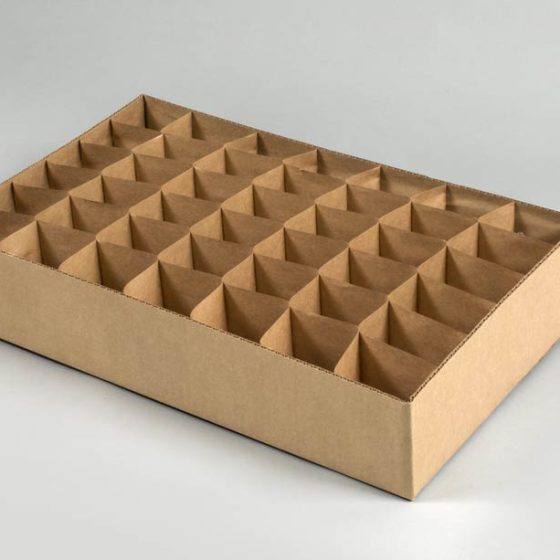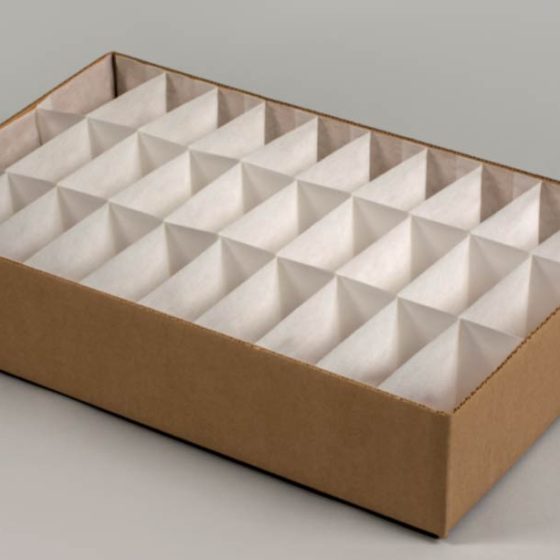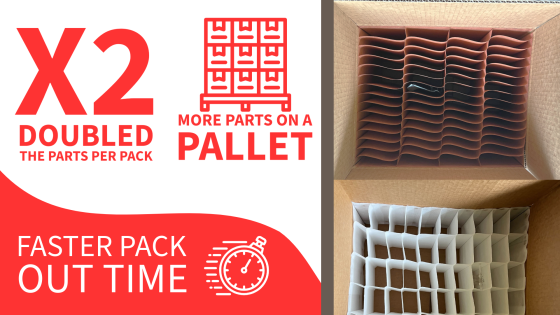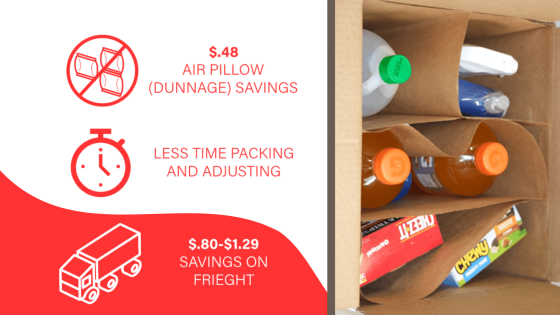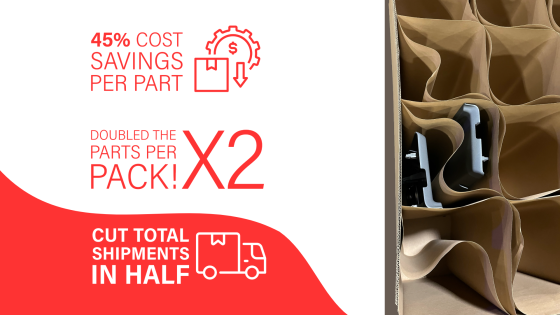Die-Cut Box Dividers vs. Integrated Packaging
Round 2 - Tooling and Die-Cut vs. No Tooling or Die-Cut
“Relying on old packaging methods is like using a typewriter in the digital age – it’s time to upgrade.”

In this article:
INTRODUCTION
A revolution is underway in the world of packaging. Traditional corrugated box dividers, once the industry standard, face a formidable challenger: integrated packaging dividers.
This article, part of a series comparing these two solutions, focuses on a critical aspect of their production: tooling and die-cutting versus no tooling or die-cutting.
Why it Matters
As we step into the ring, we’ll explore why eliminating die-cutting and tooling from the manufacturing process offers significant advantages, potentially transforming your packaging efficiency and cost-effectiveness.
What is Die-Cutting and Tooling? Die-cutting and tooling are traditional packaging processes that cut, shape, and form materials like cardboard and corrugated into specific designs. Tooling involves creating and maintaining the dies, the metal tools that stamp out these shapes.
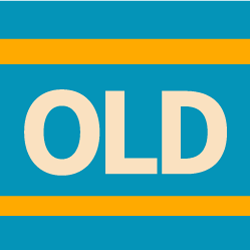
IN THE BLUE CORNER:
TRADITIONAL DIE-CUT BOX DIVIDERS
Disadvantages of Tooling and Die-Cut Methods
Using traditional die-cut dividers in manufacturing has several notable disadvantages. These drawbacks highlight the need for die-cut packaging alternatives in modern manufacturing.
- Time-Consuming Processes: Tooling and die-cutting methods extend production time, resulting in longer lead times and reduced flexibility to meet changing market demands.
- Material Waste and Inefficiency: Die-cutting produces substantial material waste, mostly non-reusable, increasing both waste and costs.
- Limited Flexibility: Changes in packaging design typically require new tooling, hindering quick adaptation to new product sizes or configurations—a significant drawback in industries with frequently changing product dimensions.
- Increased Labor Costs and Complexity: Die-cutting machinery setup and operation demand specialized skills and additional labor, introducing complexity that can lead to errors and increased costs.
- Dust Generation: Die-cutting processes often produce significant amounts of dust, which can contaminate products and packaging. This dust can be particularly problematic for industries with strict cleanliness requirements, potentially leading to quality control issues and increased cleaning costs.
These disadvantages highlight the limitations of traditional die-cut dividers and underscore the benefits of transitioning to more modern, integrated packaging solutions that eliminate the need for these outdated processes.
Definition and Examples of Integrated Dividers
Definition: Integrated packaging dividers are a modern solution that combines a single SKU collapsible carton with pre-installed dividers. This innovative approach eliminates the need for separate dividers and additional labor for assembly. Depending on the material used, the dividers are either pre-glued or sewn into the carton, creating a ready-to-use packaging solution that can be quickly deployed without the need for tooling or die-cutting processes.
Kraft paper integrated packaging.
Elite fabric integrated packaging dividers.
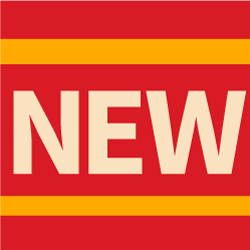
IN THE RED CORNER:
NEW INTEGRATED PACKAGING DIVIDERS
Benefits of No Die-Cutting and Tooling
Packaging manufacturers who eliminate tooling and die-cutting processes experience several advantages, which they can then pass on to their customers:
- Cost-Effective: Integrated dividers significantly reduce production costs by eliminating expensive tooling and die-cut processes.
- Faster Turnaround: Without the delays associated with die-cutting, integrated packaging allows for immediate manufacturing, leading to quicker lead times.
- Less Material Waste: This approach minimizes excess scrap material, aligns with sustainable practices, and reduces overall production costs.
- Optimized Packaging Process: Integrated dividers simplify workflows by avoiding complex tooling setups, resulting in quicker transitions between packaging requirements and reduced downtime.
- Labor Efficiency: By minimizing manual labor associated with die-cutting and assembly, integrated solutions lower labor costs and enhance productivity, allowing employees to focus on other critical tasks.
- Reduced Dust: Integrated packaging solutions significantly reduce dust generation during the manufacturing process. This results in cleaner packaging for end users, potentially reducing cleaning requirements in sensitive environments. The reduced dust also contributes to a healthier work environment for packaging staff.
REAL-WORLD EXAMPLES:
INTEGRATED PACKAGING CASE STUDY
To illustrate the tangible benefits of integrated packaging solutions, consider these results:
Challenge: An injection molding company was using traditional corrugated boxes with manually assembled partitions for T-20 bezels and side turns. They needed to enhance part density while maintaining the overall pack size.
Solution: A collapsible single SKU design with pre-glued inserts, eliminating manual insertion.
Results:
- Doubled pack density (from 30 to 60 parts per pack)
- Reduced cost per part by 30-65%
- Increased parts per pallet by 200-233%
- Streamlined packaging process and reduced labor requirements
More Case Studies
Optimizing Packaging Efficiency: Doubling Part Density for an Injection Molding Company
https://itbpackaging.com/wp-content/uploads/2024/05/Untitled-2024-05-29T164056.815-1024x576.png 1024 576 ITB Packaging ITB Packaging https://itbpackaging.com/wp-content/uploads/2024/05/Untitled-2024-05-29T164056.815-1024x576.pngE-commerce Case Study: Beauty and Personal Care Packaging
https://itbpackaging.com/wp-content/uploads/2024/04/Untitled-1-1024x576.jpeg 1024 576 ITB Packaging ITB Packaging https://itbpackaging.com/wp-content/uploads/2024/04/Untitled-1-1024x576.jpegE-commerce Case Study: Grocery Delivery Packaging
https://itbpackaging.com/wp-content/uploads/2024/04/Untitled-2024-04-05T163513.676-1-1024x576.png 1024 576 ITB Packaging ITB Packaging https://itbpackaging.com/wp-content/uploads/2024/04/Untitled-2024-04-05T163513.676-1-1024x576.pngTIER 1 SUPPLIER CASE STUDY
https://itbpackaging.com/wp-content/uploads/2024/03/Untitled-2024-03-22T101215.745-1024x576.png 1024 576 ITB Packaging ITB Packaging https://itbpackaging.com/wp-content/uploads/2024/03/Untitled-2024-03-22T101215.745-1024x576.pngTABLE COMPARISON:
DIE-CUT VS. INTEGRATED PACKAGING
METRIC
Initial Setup Cost:
Production Time:
Material Waste:
Flexibility:
Labor Requirements:
Customization:
Turn Around:
Cost Per Part:
Sustainability:
Dust Generation:
Scalability:
TRADITIONAL DIE-CUT
Higher
Limited
Less
Higher
Slower
Limited
Higher
Limited
High
Longer
High
INTEGRATED SOLUTIONS
Lower
High
More
Lower
Faster
High
Lower
High
Low
Shorter
Low
THE JUDGES' SCORECARD:
IMPACT ON PACKAGING PROCESS AND EFFICIENCY
When packaging manufacturers produce integrated dividers without tooling and die-cutting, the impact on their overall processes and efficiency is profound, leading to benefits they can extend to their customers:
- Efficiency Gains: Integrated dividers can be produced and implemented faster than traditional corrugated dividers, leading to quicker turnaround times and the ability to meet tight deadlines more efficiently.
- Labor Savings: By reducing the manual labor required for die-cutting and assembly, integrated dividers allow businesses to lower labor costs and optimize their workforce. This streamlined process also reduces the potential for errors, enhancing efficiency and product quality.
- Cost Savings: The combination of reduced material waste, lower labor costs, and faster production times leads to substantial manufacturing cost savings. Integrated packaging dividers provide a more economical solution that still delivers high-quality protection and performance, making them a smart choice for businesses looking to improve their bottom line.
- Cleaner Process: Integrated packaging solutions significantly reduce dust generation during the manufacturing process. This results in a cleaner work environment, minimizing contamination risks for both the packaging facility and end-users. The reduced dust contributes to improved air quality, potentially lower cleaning costs, and better overall product quality, especially crucial for industries with strict cleanliness requirements.
Overall, integrated packaging dividers offer a more efficient and cost-effective alternative to traditional corrugated packaging dividers, helping businesses streamline their operations and achieve greater productivity.
THE WINNER BY TECHNICAL KNOCK-OUT:
INTEGRATED PACKAGING DIVIDERS
Integrated packaging dividers represent a significant advancement over traditional corrugated box dividers. By choosing packaging manufacturers and suppliers that eliminate the need for tooling and die-cutting, businesses can reduce costs, minimize material waste, and create a more efficient packaging process. This approach adapts well to changing demands in today’s fast-paced market.
As companies seek to streamline operations and improve their bottom line, integrated packaging solutions offer a compelling alternative. Evaluating these modern approaches can lead to better business outcomes through enhanced productivity and resource optimization.
Explore ITB Packaging’s Integrated Dividers
Experience the advantages of tooling-free and die-cut-free packaging solutions. ITB Packaging’s innovative integrated dividers offer:
- Streamlined Production
- Significant Labor Savings
- Cost Effective Design
- Smarter Product Protection
Don’t let outdated methods hold your business back. Discover how ITB Packaging’s revolutionary approach can enhance your efficiency and reduce costs. Take the next step towards optimizing your packaging process—explore our solutions today.
“Our integrated solutions are more relevant than ever, as the challenges of labor shortages, storage limitations, handling inefficiencies, rising freight costs, and supply chain disruptions—prompted by the pandemic—continue to impact various industries.”—Jeff Tischleder, President, ITB Packaging

